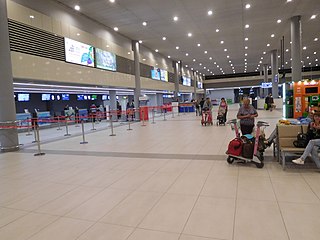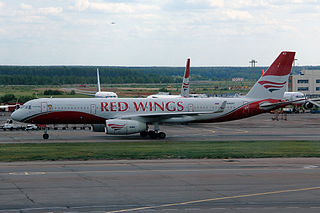
The Tupolev Tu-104 is a retired medium-range, narrow-body, twin turbojet-powered Soviet airliner. It was the second to enter regular service, behind the British de Havilland Comet and was the only jetliner operating in the world from 1956 to 1958, when the British jetliner was grounded due to safety concerns.

The Tupolev Tu-154 is a three-engined, medium-range, narrow-body airliner designed in the mid-1960s and manufactured by Tupolev. A workhorse of Soviet and (subsequently) Russian airlines for several decades, it carried half of all passengers flown by Aeroflot and its subsidiaries, remaining the standard domestic-route airliner of Russia and former Soviet states until the mid-2000s. It was exported to 17 non-Russian airlines and used as a head-of-state transport by the air forces of several countries.

Pulkovo Federal State Unified Aviation Service Company was an airline with its head office in Moskovsky District, Saint Petersburg, Russia. It operated the Pulkovo Airport and was 100% state owned. It was the third largest airline in Russia. On 29 October 2006 it completed a merger with government owned Federal State Unified Aviation Service Company to form a new company under the Rossiya name.

Pulkovo Airport is an international airport serving St. Petersburg, Russia. It consists of one terminal which is located 23 km (14 mi) south of the city centre. The airport serves as a hub for Rossiya Airlines and as focus city for Smartavia. It is responsible for serving the citizens of Saint Petersburg and the Leningrad Oblast: a total of 6,120,000 people. It is the 29th-busiest airport in Europe in 2022.

China Eastern Airlines Flight 5210 (CES5210/MU5210), also known as the Baotou Air Disaster, was a flight from Baotou Erliban Airport in Inner Mongolia, China, to Shanghai Hongqiao International Airport, with a planned stopover at Beijing Capital International Airport. On 21 November 2004, just two minutes after takeoff, the Bombardier CRJ200ER fell from the sky and crashed into a lake in Nanhai Park, next to the airport, killing all 53 people on board and two more on the ground.

Perm Airlines was an airline based in Perm, Russia. It operated domestic and international scheduled and charter services within Russia and the CIS. Its main base was Bolshoye Savino Airport, Perm.

Irkutsk International Airport is an international airport on the outskirts of Irkutsk, Russia, at a distance of 60 kilometers from Lake Baikal.

Anapa Airport, also known as Vityazevo Airport is an international airport located near Vityazevo village in Anapa, Russia. It serves the resort town of Anapa, as well as Novorossiysk and Temryuk with a total population of over 400,000 people.

Belgorod International Airport is an airport in Russia located 4 km north of Belgorod. It services narrow-body airliners and wide-body airliner Boeing 767. It conducts 24-hour flight operations. The airport was founded in 1954.

Aeroflot Flight 5143 was a domestic scheduled Karshi–Ufa–Leningrad passenger flight that crashed near Uchkuduk, Uzbek SSR, Soviet Union, on 10 July 1985. The crash killed all 200 occupants on board. Investigators determined that crew fatigue was a factor in the accident.
CJSC "Air Company ALROSA", formerly Alrosa Mirny Air Enterprise is an airline from Mirny, Russia. Its bases are at Mirny Airport and Polyarny Airport, with a focus city at Lensk Airport. The airline operates scheduled and chartered domestic flights.

Vladivostok Air Flight 352 was a scheduled passenger flight from Yekaterinburg, Russia to Vladivostok via Irkutsk. On 4 July 2001, the aircraft operating the flight, a Tupolev Tu-154M with tail number RA-85845, lost control, stalled, and crashed while approaching Irkutsk Airport. All 136 passengers and 9 flight crew members aboard perished, making it the third deadliest aircraft crash over Russian territory to date after Aeroflot Flight 3352 and Aeroflot Flight 217.

Aeroflot Flight 3352 was a regularly scheduled Aeroflot flight from Krasnodar to Novosibirsk, with an intermediate landing in Omsk. While landing at Omsk Airport on Thursday, 11 October 1984, the aircraft crashed into maintenance vehicles on the runway, killing 174 people on board and four on the ground. While a chain of mistakes in airport operations contributed to the accident, its major cause was an air traffic controller falling asleep on duty. As of 2022, this remains the deadliest aviation accident on Russian territory. It was also the deadliest aviation accident involving a Tupolev Tu-154 at the time until the crash of Aeroflot Flight 5143 nine months later; as of 2023, it still ranks as the second-deadliest accident involving a Tupolev Tu-154. The tragedy was kept secret for twenty years, until Komsomolskaya Pravda published an article in 2004.

Dagestan Airlines Flight 372 was a scheduled commercial flight between Moscow's Vnukovo Airport and Makhachkala, Russia. On 4 December 2010, the Tupolev Tu-154 operating the flight skidded off the runway following an emergency landing at Domodedovo Airport, 45 kilometres (28 mi) south-east of Vnukovo. Two people on board were killed.

Red Wings Airlines Flight 9268 was a Tupolev Tu-204-100 passenger jet that on 29 December 2012 crashed on landing at Moscow Vnukovo Airport, Russia, following a repositioning flight from Pardubice Airport, Czech Republic. There were no passengers on board, but 5 of the 8 crew members were killed when the aircraft hit a ditch and highway structures after overrunning the runway.

Flydubai Flight 981 (FZ981/FDB981) was a scheduled international passenger flight from Dubai, United Arab Emirates, to Rostov-on-Don, Russia. On 19 March 2016, the Boeing 737-800 aircraft operating the flight crashed during a go-around, killing all 62 passengers and crew on board.

Aeroflot Flight 3739 was a regularly scheduled Russian domestic flight from Irkutsk to Pulkovo Airport in Saint Petersburg that crashed during takeoff from Irkutsk International Airport on 9 February 1976. Twenty-four of the 114 people on board died in the accident.

Pulkovo Aviation Enterprise Flight 9560 was a repositioning flight from Sheremetyevo International Airport in Moscow to Pulkovo Airport in St. Petersburg. On 28 July 2002, the Ilyushin Il-86 aircraft operating the flight crashed after take-off from Sheremetyevo. 14 of the 16 crew members on board were killed, making the crash the deadliest aviation accident involving the Ilyushin Il-86.
Events in the year 2006 in Ukraine.


















